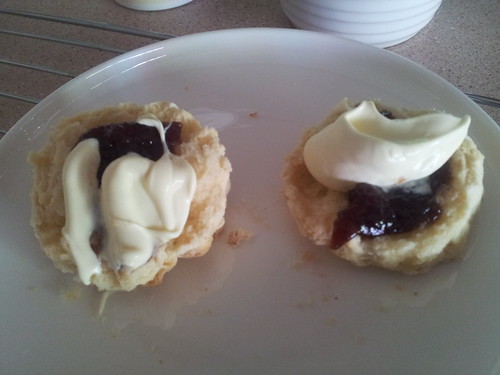I haven’t made scones for absolutely ages. I can remember the last occasion I made them but I can’t quite place a date, so that means it was a long time ago.
A friend back in England, let’s call him Chris THOR (apparently Chris wasn’t rock & roll enough!), has been quizzing me on scones and what better way to answer the questions than to make them myself?
I do actually have a Green & Gold Cookbook, which I’m sure has the be-all and end-all of scone recipes, but I couldn’t exactly email that off to the other side of the world so I found this simple lemonade scone recipe and suggested he give it a try.
Goodness me – hasn’t there half been a flurry of questions ensuing from that suggestion! Chris THOR was thrown off (quite legitimately, in my opinion) by the fact that the recipe uses cup measures, rather than ‘proper’ measures. But, it does redeem itself by not mix and matching its weights and measures … and baking is all about ratios.
For the benefit of anyone reading who finds themselves frustrated by the use of the cup measure, here’s a brief explanation.
1 cup = 250 mL
(that’s a metric cup, of course, your cup may be a US customary cup then it’s 237 mL … or perhaps it’s a US legal cup and then it’s 240 mL and if it’s an Imperial cup then it’s 284 mL)
For reference, whenever I say ‘cup’ in a recipe on Eating Adelaide (and I do try to use it only for wet ingredients) I mean 250 mL.
I’d prefer dry ingredients always be weighed out but a metric cup is approximately 120 – 150 g of flour.
However, in the case of this recipe, I think we can roll with the cup measure because there are just three ingredients and it’s all about the ratios.
The real trick with scones (and this is something the original post goes into in a LOT of detail – I encourage you to read it if you’re not feeling confident) is to work VERY VERY lightly. You do not need to crack out fancy kitchen kit. You need a bowl, a cup measure and a knife. Simply cut the mixture together, tip it out on to the bench and pull it together with a very light touch. If you can avoid a rolling pin, do. And keep the dough quite high – the Internet Chef says 2.5 – 3 cm – I didn’t manage quite that high but mine still rose well and were lovely and light.
The real bonus with this recipe (besides the fact that it’s just THREE ingredients – have I already mentioned that?!) is that there is no baking powder in this recipe so you don’t end up with that nasty metallic flavour/feeling on the back of your teeth … even if you do eat two or three!
This recipe makes about 10 scones roughly 5 cm in diameter. It’s easy to scale up – just keep the ratios the same and maintain your light touch!
Ingredients
- 1½ cups self raising flour
- ½ tsp salt
- ½ cup lemonade
- ½ cup cream
Instructions
- Preheat your oven to 220°C fan and place a small tray in to heat up.
- To make the scones, put the flour in a bowl, mix in the salt and then form a well.
- Add the lemonade and cream and mix it together by cutting through with an ordinary table knife.
- Once the mixture has come together (it will be crumbly), tip it out onto the bench and lightly work it together. You may not even need to put additional flour on the bench.
- Pat the dough into a disk about an inch thick (for the highest scones - thinner it will be OK but don't go flattening it out - it's not pastry!) and cut out your scones.
- Remove the heated tray from the oven, dust lightly with flour and put the scones on the tray.
- Place them touching each other for support as they rise.
- Lightly brush with milk (the original recipe suggests egg yolk and cream, but I already have egg whites which need using!) and bake for 12-15 minutes. In my oven, 12 minutes was spot on.
- Remove from the oven and allow to cool on the tray a little before moving to a rack.
- Eat warm with jam and cream or buttered.

